About Danse Macabre:
<--more>
The composition is based upon a poem by Henri Cazalis, on an old French superstition:Musical Musings cautions:
Zig, zig, zig, Death in a cadence,According to the ancient superstition, "Death" appears at midnight every year on Halloween. Death has the power to call forth the dead from their graves to dance for him while he plays his fiddle (represented by a solo violin with its E-string tuned to an E-flat in an example of scordatura tuning). His skeletons dance for him until the first break of dawn, when they must return to their graves until the next year.
Striking with his heel a tomb,
Death at midnight plays a dance-tune,
Zig, zig, zig, on his violin.
The winter wind blows and the night is dark;
Moans are heard in the linden trees.
Through the gloom, white skeletons pass,
Running and leaping in their shrouds.
Zig, zig, zig, each one is frisking,
The bones of the dancers are heard to crack—
But hist! of a sudden they quit the round,
They push forward, they fly; the cock has crowed.
The Danse Macabre (French for Dance Of Death) became a cultural symbol in late Medieval Europe. Artists painted scenes of the dead escorting the living to the grave with a final dance of death. The reality of a sudden and painful death were all too vivid after the horrors of the bubonic plague, the 'Black Death' epidemics of the 14th century. It is estimated that 40 to 50 percent of the total population of Europe perished in a four-year period.
The notion that death was the fate of all, as stated in the Latin motto that accompanied many of the artworks depicting the Dance of Death, Momento Mori (remember you will die) expresses the sentiment that no matter a person's position in society or station in life, our fate is the same. While the notion of death has been romanticized to a certain degree over the years and even trivialized in cartoons and videos, the Dance of Death was very real to people of earlier times.












